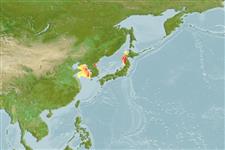>
Callionymiformes (Dragonets) >
Callionymidae (Dragonets)
Etymology: Callionymus: Greek, kallion, comparative of kallos = beautiful + Greek, onyma = name; with a better name; leucopoecilus: From the Greek word 'leucos' meaning white, light and 'poecilos' meaning spotted, referring to the numerous light spots on the dorsal parts of the head and body.
More on authors: Fricke & Lee.
Environment: milieu / climate zone / depth range / distribution range
Ekologi
marina bottenlevande. Temperate
Northwest Pacific: Korea.
Size / Vikt / Age
Maturity: Lm ? range ? - ? cm
Max length : 8.4 cm SL hane/ej könsbestämd; (Ref. 11665); 7.9 cm SL (female)
Life cycle and mating behavior
Könsmognad | Reproduktion | Lek | Ägg | Fecundity | Larver
Fricke, R. and C.-L. Lee, 1993. Callionymus leucopoecilus, a new dragonet (Callionymidae) from the Yellow Sea. Jap. J. Ichthyol. 39(4):275-279. (Ref. 11665)
IUCN Red List Status (Ref. 130435: Version 2024-1)
Threat to humans
Harmless
Human uses
Verktyg
Special reports
Download XML
Internet-källor
Estimates based on models
Preferred temperature (Ref.
123201): 4.9 - 14.6, mean 10.3 °C (based on 13 cells).
Phylogenetic diversity index (Ref.
82804): PD
50 = 0.5000 [Uniqueness, from 0.5 = low to 2.0 = high].
Bayesian length-weight: a=0.00891 (0.00410 - 0.01937), b=2.78 (2.60 - 2.96), in cm total length, based on LWR estimates for this Genus-body shape (Ref.
93245).
Trofisk nivå (Ref.
69278): 3.2 ±0.4 se; based on size and trophs of closest relatives
Resiliens (Ref.
120179): Hög, lägsta populationsfördubblingstid mindre än 15 månader (Preliminary K or Fecundity.).
Fishing Vulnerability (Ref.
59153): Low vulnerability (10 of 100).
